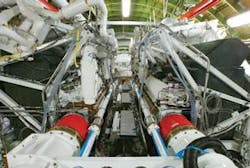HIGH-POWER LASERS: Airborne Laser achieves lethal antimissile power levels

The Airborne Laser (ABL) team, led by Boeing (Chicago, IL), announced in December the successful completion of a series of tests involving its high-energy laser at the Systems Integration Lab at Edwards Air Force Base in California. The announcement came less than two weeks after Reuters reported a request from the White House in early November that the Pentagon consider dropping the ABL project from the 2007 budget.
When initially launched by the Air Force in 1996, the estimated cost was $2.5 billion with a projected deployment of the completed weapon system in 2006. Cost estimates have since climbed past $5 billion and projected deployment dates have pushed through 2010.
As this article went to press, the FY07 budget had not yet been finalized and sent by the President to Congress. Richard Lehner at the Missile Defense Agency (Washington, D.C.) did comment, however. “Congress has been generally satisfied with the progress of the ABL technology, especially the recent test when we achieved a full-duration lase that would have been sufficient to destroy a boosting missile,” he said.
During that test series, which was reported in December, lasing duration and power were demonstrated at levels suitable for the destruction of multiple classes of ballistic missiles. Tests included more than 70 separate lasing events, as well as operation at simulated altitude, and achieved steady-state operations under full optical control, according to Boeing. The ABL megawatt-class chemical oxygen iodine laser (COIL) was designed and built by Northrop Grumman (Los Angeles, CA).
In July 2005, the ABL team completed flight testing of the system’s passive mission payload at Edwards Air Force Base. During those tests, the team demonstrated the stability and alignment of the two Beam Control and Fire Control optical benches with the turret. That test also demonstrated the system’s pointing and vibration-control functions, as well as its ability to acquire targets as directed by the battle-management segment. The next step for the program is integrated systems testing.
Final modifications
The YAL-1A aircraft housing the ABL has been moved to Boeing’s Wichita, Kansas, facility for final modifications in preparation for installation of the High Energy Laser modules, and to begin Low Power System Integration-Active ground and flight testing. During active testing, the kilowatt-class illuminator lasers will be integrated and tested to demonstrate target acquisition, fine tracking, pointing, and atmospheric compensation. Upon completion of active testing, the YAL-1 will return to Edwards Air Force Base for installation of the High Energy Laser, which will be removed from the System Integration Laboratory. This will be followed by extensive weapon-systems testing on the aircraft—both on the ground and in flight.
“This is a major technological achievement for the Airborne Laser program,” said Pat Shanahan, vice president and general manager of Boeing Missile Defense Systems (St Louis, MO). “We have made continued steady progress on this program, breaking new technological ground every day, with each test increment leading to the lethal shoot-down milestone.”
Lockheed Martin (Bethesda, MD) is the third partner in the ABL project and provides the beam-control/fire-control segment that contains state-of-the-art optics for control of the solid-state illuminators for tracking and atmospheric compensation, as well as for the High Energy Laser. Lockheed also provides ABL’s flight-turret assembly.
About the Author
Hassaun A. Jones-Bey
Senior Editor and Freelance Writer
Hassaun A. Jones-Bey was a senior editor and then freelance writer for Laser Focus World.